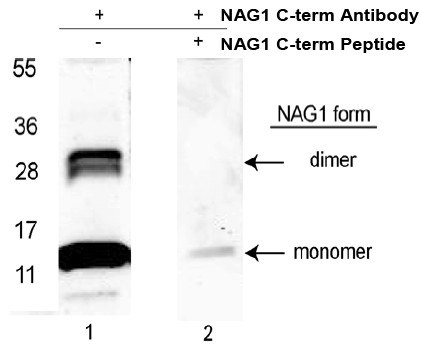GDF15 (C-term) Rabbit Polyclonal Antibody
Other products for "GDF15"
Specifications
| Product Data | |
| Applications | ELISA, WB |
| Recommended Dilution | ELISA: 1/300,000. Western Blot: 2,000-10,000. |
| Reactivities | Chimpanzee, Human, Macaque, Mouse, Rat |
| Host | Rabbit |
| Isotype | IgG |
| Clonality | Polyclonal |
| Immunogen | Synthetic peptide corresponding to the C-terminal sequence of NAG-1 protein. A residue of cysteine was added to facilitate coupling |
| Specificity | This antibody reacts with the C-terminus of endogenous NAG-1 protein. |
| Formulation | 0.02M Potassium Phosphate, 0.15M Sodium Chloride, pH 7.2 State: Aff - Purified State: Liquid purified IgG fraction Stabilizer: None Preservative: 0.09% (w/v) Sodium Azide |
| Concentration | lot specific |
| Purification | Affinity Chromatography |
| Conjugation | Unconjugated |
| Storage | Upon receipt, store undiluted (in aliquots) at -20°C. Avoid repeated freezing and thawing. Shelf life: one year from despatch. Storage Conditions for Trial Size: This vial contains a relatively low volume of reagent (25 µl). To minimize loss of volume dilute 1:10 by adding 225 µl of the buffer stated above directly to the vial. Recap, mix thoroughly and briefly centrifuge to collect the volume at the bottom of the vial. Use this intermediate dilution when calculating final dilutions as recommended below. |
| Stability | Shelf life: 3 month from despatch. |
| Gene Name | growth differentiation factor 15 |
| Database Link | |
| Background | The non-steroidal antiinflammatory drug (NSAID) activated gene (NAG-1) is a member of the transforming growth factor-beta (TGF-beta) superfamily. NAG-1 is also known as Macrophage Inhibitory Cytokine-1 (MIC-1), Growth Differentiation Factor 15 (GDF15), Placental Bone Morphogenetic Protein (PLAB), or Prostate Derived Factor (PDF). NAG-1 is expressed in human placenta, prostate and colon. It possesses antitumorigenic and proapoptotic activities. NAG-1 expression is dramatically increased in inflammation, injury and malignancy. Increase of NAG-1 expression is a feature of many cancers including breast, colon, pancreas and prostate. In a number of studies, NAG-1 expression was increased by a number of NSAIDs. This increase in expression may correlate with the chemopreventive effect NSAIDs seem to have with certain cancers. NAG-1 expression is also induced by PPAR gamma ligands and by several dietary compounds such as conjugated linoleic acids (CLAs), naturally occurring fatty acids in ruminant food products, indoles, epicatechin gallate, and genistein. The induced expression of NAG-1 results in a stimulation of apoptosis and inhibition of cell growth. Inhibition of NAG-1 induced expression by small interference RNA (siRNA) results in repression of induced apoptosis. NAG-1 expression is regulated by a numbers of transcription factors such as ERG-1 and Sp1. EGR-1 may be necessary for NSAID-induced NAG-1 expression. The study of expression of NAG-1 proteins, including variants, is important to define their potential role as serum biomarkers for cancer diagnosis, treatment monitoring, epidemiology study, and nutrition surveys. |
| Synonyms | GDF-15, MIC1, PDF, PLAB, PTGFB, Growth/differentiation factor 15, Placental bone morphogenetic protein, Placental TGF-beta, Macrophage inhibitory cytokine 1, MIC-1, Prostate differentiation factor, NSAID-activated gene 1 protein, NAG-1, NSAID-regulated gene 1 protein, NRG-1 |
| Reference Data | |
Documents
| Product Manuals |
| FAQs |
| SDS |
{0} Product Review(s)
0 Product Review(s)
Submit review
Be the first one to submit a review
Product Citations
*Delivery time may vary from web posted schedule. Occasional delays may occur due to unforeseen
complexities in the preparation of your product. International customers may expect an additional 1-2 weeks
in shipping.






























































































































































































































































 Germany
Germany
 Japan
Japan
 United Kingdom
United Kingdom
 China
China



